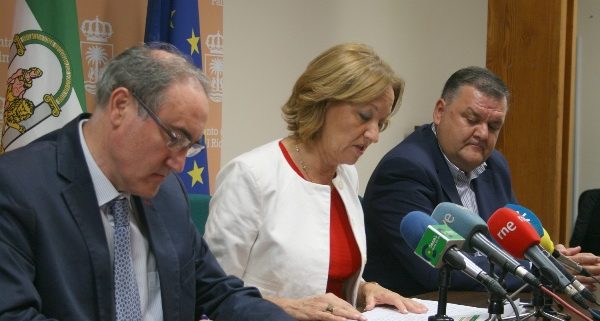Andalusia estimates more than two million tons of citrus
The capacity of the 2016-17 citrus season in Andalusia expected to exceed two million tons of production (2,059,833), a figure that would be an increase from the previous year of 10.5%. These data were recently presented by the Minister of Agriculture, Fisheries and Rural Development of the Government of Andalusia, Carmen Ortiz, in Palma del Río.
Carmen Ortiz explained that this improvement is due “to good weather conditions in the spring and the absence of problems in fruit set“. By provinces, Sevilla remains the main producer -over the 932,000 tonnes and is expected a significant increase in the harvest of 33.2%.
Carmen Ortiz clarified that if the basis of the current information is expected “a good campaign production”, however we must bear in mind that the final data will depend on weather conditions throughout the campaign.
If confirmed data, 2016-2017 harvest will be 8.2% higher than the average of the last four years
During her speech, the minister stressed the importance of channeling supply through producer organizations Fruit and Vegetables (OPFHs) and other entities that can generate higher remuneration for producers and “value added stay here at Andalusia“. “If we are able to properly market, this increased harvest will also result in wealth for our land,” Ortiz remarked.
As for the national data, it is estimated that global production exceeds seven million tons, so Andalusia brings around 30% of the volume of citrus Spain, the second region after Valencia (3.9 million tons).
Andalusia has about 12.000 citrus farms, totaling nearly 85.000 hectares of crops dedicated mainly to orange (70%) and tangerine (21%)
Considering employment generation, the citrus industry is the third in importance of agriculture in Andalusia, with nearly seven million jobs, of which 65% corresponds to production work (including harvesting) and 35 % to plants manipulated. The fruit harvesting generates 2.8 million jobs (40% of the total).
In 2015, the value of the citrus production amounted to 522 million euros, amount which represents around 5% of the agricultural industry in Andalusia
First capacity per species and provinces
In the case of sweet orange crop that accounts for 75% of the Andalusian citrus production it is expected to increase 17% over the previous season and over 1.5 million tons. For tangerine, however, it is expected a reduction of 9% (356 838 tons). Also down 4% lemon production (103,285 tonnes) and 3% of grapefruits (19,177 tons). Bitter orange production will increase by 19.5% (12,927 tonnes).
By provinces, especially it highlights the projected increase in Seville, which accounts for 45% of total Andalusian. The second province with the largest citrus production, Huelva, on the other hand recorded a decrease of 14% (406,583 tons). Almeria is expected to grow 24% (261,542 tons). Córdoba (221,785 tons) and Malaga (161,102), will experience a decrease of 3% and 10%, respectively. Also descend harvest in Cadiz, 4% (58,668 tons), while the province with lower production, Granada, which will be accounted for the largest increase, 46.4% (17,912 tonnes).
Exports
Carmen Ortiz reported that, according to data currently available to the Ministry of Agriculture, Fisheries and Rural Development (CAPDER) in the 2015-2016 campaign saw an improvement in sales abroad. “Although it has reduced the volume of citrus exported from Andalusia almost 15%, the value has increased by 3% to 227 million euros, thanks to better prices”, she explained.
Ortiz noted that exports of citrus in Andalusia amounts to just 15% of what is produced, “well below Valencia, which exports more than 60% of its production volume”
In 2015, the value of exports of Andalusian oranges exceeded 142 million euros, while tangerine amounted to 46.5 million euros. The European Union is the main destination of exported Andalusian citrus, mainly Germany and France; while Canada is the most important non-EU customer.
EU-South Africa agreement
Before the public presentation of capacity, Carmen Ortiz presided over the seventh meeting of the Bureau of Citrus Andalusia, which addressed, among other issues, the situation of international relations in the sector, R & D and knowledge transfer citrus and control campaign to prevent the marketing of green oranges.
Specifically, those attending the meeting analyzed the economic partnership agreement recently signed between the European Union (EU) and the Community of South Africa, which involves extending until the end of November period export of South African oranges EU free of tariffs, coinciding with the time of production of Andalusia. The Minister reported that, as agreed at this meeting table citrus, will contact with the Minister of Agriculture, Food and Environment, Isabel García Tejerina, to transfer the concern of Andalusia for the consequences you could have the agreement.
Carmen Ortiz commented that expected to carry out a study of the possible impact of the agreement for the citrus sector and compensation measures in case adversely affected producers. In addition, the Minister of Agriculture has stressed the importance of “compliance to the letter” the legislation on phytosanitary control, as among the concerns of farmers is the possibility of arriving fruits affected by the disease known as “black spot”.
For Ortiz, citrus imports, but “are not very prominent in our country, is something we must watch” in the European context, not only because of the oversupply that occurs at times, but also for “phytosanitary risks for our productions “
The entry of citrus in the Andalusian Autonomous Community represents just 3.6% of the value of fruit exported from Andalusia and mainly from Morocco, Portugal, the Netherlands and South Africa.
Source: CAPDER









